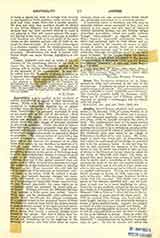

Ampere, ANDRE-MARIE, physicist and mathematician, b. January 22, 1775, at Lyons, France; d. at Marseilles, June 10, 1836. His father was a prosperous and educated merchant, his mother charitable and pious, while he himself combined the traits of both. The mathematical bent of his mind showed itself very early. Before he knew his letters and numbers he is said to have performed complex arithmetical computations by means of pebbles and beans. His childhood days were spent in the village of Poleymieux-les-Mont-d’Or, near Lyons. His father began to teach him Latin, but, on discovering the boy’s thirst for mathematical knowledge, he provided him with the necessary books. It was not long before he had mastered the elements of his chosen study, so that his father was obliged to take the boy of eleven to the library at Lyons, where he asked for the works of Bernouilli and Euler. On being informed that these books were written in Latin, and that he would need a knowledge of the calculus, he resumed the study of the one and applied himself to that of the other, and at the end of a few weeks was able to take up the serious perusal of difficult treatises on applied mathematics. During the revolution his father returned to Lyons, in 1793, expecting to be safer in the city. After the siege, however, he fell a victim and was executed. This death was a great shock to the delicate, sensitive boy, who for more than a year was in a state bordering on idiocy. From this he was suddenly aroused by the reading of two works: J. J. Rousseau’s “Letters on Botany” and Horace’s “Ode to Licinius”, which led him to the immediate study of plants and of the classic poets. In 1799 he married Julie Carron, who lived only five years longer, leaving a son who afterwards became a writer of great literary merit. Ampere was obliged to teach in order to support himself and family. At first he gave private lessons in Lyons; later, in 1801, he left his wife and child to take the chair of physics at the Ecole Centrale in Bourg. There he wrote the article that attracted the attention of Lalande and Delambre: “Considerations sur la theorie mathematique du jeu”. In this he attacks and solves the problem of showing that the chances of the gambler are always against him. It is noted for its elegant and polished, though simple, application of the calculus of probabilities. The favorable appreciation of his work by men like Delambre resulted in his call to Lyons and later, in 1805, to the Ecole Polytechnique at Paris, where, in 1809, he rose to the position of Professor of Analysis, and was made Chevalier of the Legion of Honor, and where his work alternated between mathematics, physics, and metaphysics. He published a number of articles on calculus, on curves, and other purely mathematical topics, as well as on chemistry and light, and even on zoology. Ampere’s fame, however, rests on his remarkable work in electro-dynamics. It was on September 11, 1820, that an academician, returning from Geneva, repeated before the Academy the epoch-marking experiments of the Danish savant Oersted. A wire through which an electric current passes was shown to deflect a magnetic needle, causing it to place itself at right angles to the direction of the current. The connection between electricity and magnetism was indicated by these experiments, and the foundation was laid for the science of electro-magnetics. Only a week later, on the 18th of the same month, Ampere demonstrated before the Academy another remarkable fact: the mutual attraction or repulsion of two parallel wires carrying currents, according as the currents are in the same or in opposite directions. This laid the foundation of the science of electro-dynamics.
Ampere continued his experiments, published the results in 1822, and, finally, developed his “Mathematical Theory of the Phenomena of Electro-dynamics” in 1830. In 1821 he suggested an electric telegraph, using separate wires for every letter. His final work, published after his death, was the ambitious “Essai sur la philosophie des sciences, ou exposition analytique d’une classification naturelle de toutes les connaissances humaines”. His predilection for philosophic, psychological, and metaphysical speculation was very marked. His arduous task as teacher, together with the engrossing functions of a government official—he was Inspector-General of the University—prevented him from devoting himself more to the work of the experimenter. He was a member of the Institute of France, the Royal Societies of London and Edinburgh, the Academies of Berlin, Stockholm, Brussels, and Lisbon, and other scientific societies. In 1872 Madame Chevreux edited his “Journal and Correspondence”. In 1881 the Paris Conference of Electricians honored his memory by naming the practical unit of electric current the ampere. His religious life is interesting. He says that at eighteen years he found three culminating points in his life, his First Communion, the reading of Thomas’s “Eulogy of Descartes”, and the taking of the Bastille. His marriage to the pious Julie Carron was secretly performed by a priest, her family refusing to recognize the competency of the “constitutional” clergyman; this fact impressed him very deeply. On the day of his wife’s death he wrote two verses from the Psalms, and the prayer, “O Lord, God of Mercy, unite me in Heaven with those whom you have permitted me to love on earth”. Serious doubts harassed him at times, and made him very unhappy. Then he would take refuge in the read ing of the Bible and the Fathers of the Church. “Doubt“, he says in a letter to a friend, “is the greatest torment that a man suffers on earth”. His death took place at Marseilles, in his sixty-second year.
WILLIAM FOX

